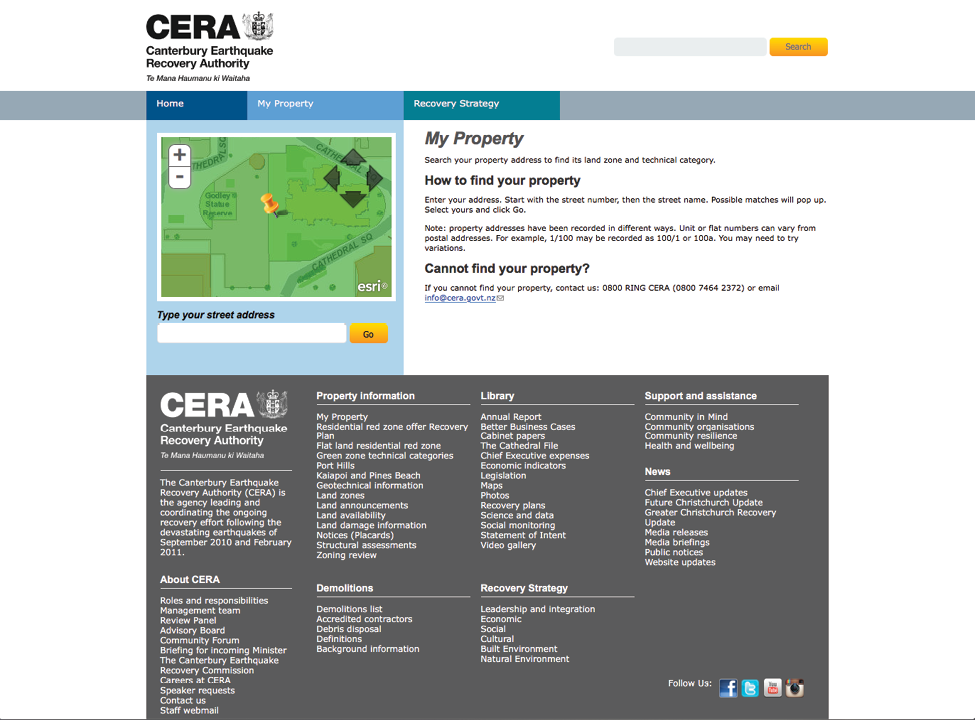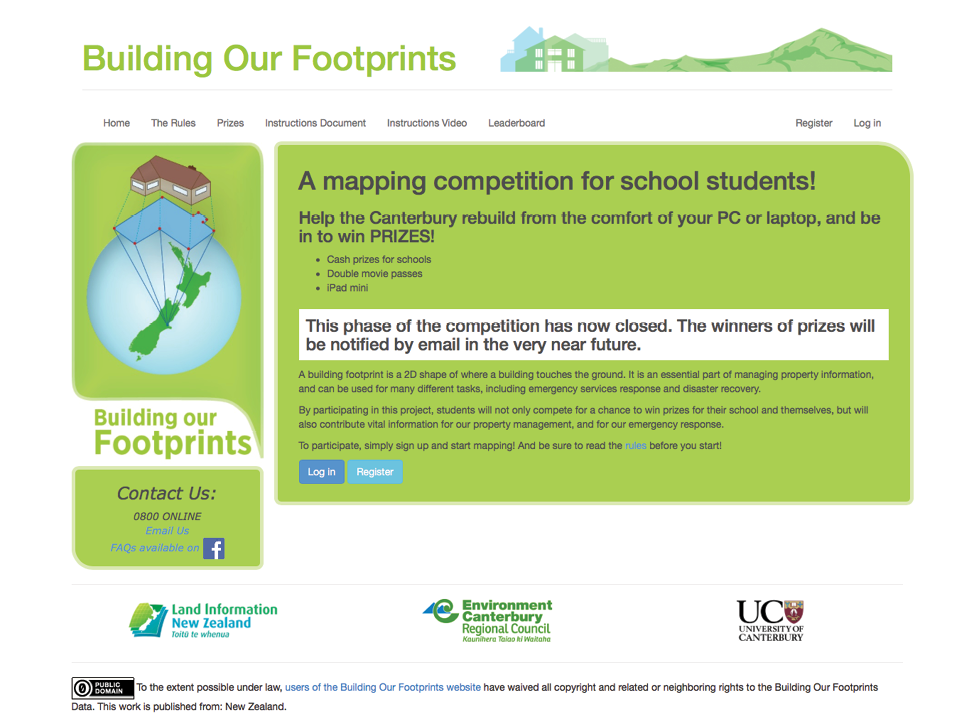The Global Impact of Open Data
New Zealand's Christchurch Earthquake Clusters
Open Data for Improving Emergency Response
by Juliet McMurren, Stefaan Verhulst and Andrew Young*
Reference
5 https://en.wikipedia.org/wiki/List_of_earthquakes_in_New_Zealand#Earthquakes_resulting_in_fatalities
14 https://www.ict.govt.nz/guidance-and-resources/open-government/declaration-open-and-transparent-government/
15 https://www.ict.govt.nz/guidance-and-resources/open-government/new-zealand-government-open-access-and-licensing-nzgoal-framework/
18 http://web.archive.org/web/20100905033623/http://earthquake.usgs.gov/earthquakes/recenteqsww/Quakes/us2010atbj.php; “Why so few casualties in Canterbury quake?” Stuff.co.nz. September 4, 2010. http://www.stuff.co.nz/national/4096813/Why-so-few-casualties-in-Canterbury-quake
19 Office of the Prime Minister’s Science Advisory Committee. “The Canterbury Earthquakes: Scientific answers to critical questions.” The Royal Society of New Zealand. 2011. http://www.royalsociety.org.nz/media/Information-paperThe-Canterbury-Earthquakes.pdf
20Campbell, Hamish. “Technically it’s just an aftershock.” New Zealand Herald. February 24, 2011. http://www.nzherald.co.nz/opinion/news/article.cfm?c_id=466&objectid=10708275
21 Lin II, Rong-Gong and Sam Allen. “New Zealand quake raises questions about L.A. buildings.” Los Angeles Times. February 26, 2011. http://www.latimes.com/local/la-me-quake-california-20110226-story.html
22 Carver, Julian. “Using the Web in Earthquake Recovery.” New Zealand Government Web Toolkit. March 25, 2013. https://webtoolkit.govt.nz/blog/2013/03/using-the-web-in-earthquake-recovery/
23 Clifton, Charles. “Christchurch Feb 22nd Earthquake: A Personal Report by Charles Clifton – March 2011.” HERA. March 2011. http://www.hera.org.nz/Story?Action=View&Story_id=1398
24 GovLab interview with Julian Carver, former Chief Information Officer, Canterbury Earthquake Recovery Authority, August 3, 2015.
25 GovLab interview with Julian Carver, former Chief Information Officer, Canterbury Earthquake Recovery Authority, August 3, 2015.
26 Clifton, Charles. “Christchurch Feb 22nd Earthquake: A Personal Report by Charles Clifton – March 2011.” HERA. March 2011. http://www.hera.org.nz/Story?Action=View&Story_id=1398
27 McNamara, Tim. “Eq.org.nz – The Power of Ushahidi.” Institute of IT Professionals TechBlog. March 18, 2011. http://techblog.nz/94-eqorgnzThePowerofUshahidi
28 GovLab interview with Julian Carver, former Chief Information Officer, Canterbury Earthquake Recovery Authority, August 3, 2015.
29 McNamara, Tim. “Eq.org.nz – The Power of Ushahidi.” Institute of IT Professionals TechBlog. March 18, 2011. http://techblog.nz/94-eqorgnzThePowerofUshahidi
30 Carver, Julian. “Using the Web in Earthquake Recovery.” New Zealand Government Web Toolkit. March 25, 2013. https://webtoolkit.govt.nz/blog/2013/03/using-the-web-in-earthquake-recovery/
31 Bell, Stephen. “Tech volunteers quick to help in quake aftermath.” Computerworld. February 24, 2011. http://www.computerworld.co.nz/article/498626/tech_volunteers_quick_help_quake_aftermath/
32 GovLab interview with Julian Carver, former Chief Information Officer, Canterbury Earthquake Recovery Authority, August 3, 2015.
33 Bell, Stephen. “Tech volunteers quick to help in quake aftermath.” Computerworld. February 24, 2011. http://www.computerworld.co.nz/article/498626/tech_volunteers_quick_help_quake_aftermath/
34 Bell, Stephen. “Tech volunteers quick to help in quake aftermath.” Computerworld. February 24, 2011. http://www.computerworld.co.nz/article/498626/tech_volunteers_quick_help_quake_aftermath/
35 McNamara, Tim. “Eq.org.nz – The Power of Ushahidi.” Institute of IT Professionals TechBlog. March 18, 2011. http://techblog.nz/94-eqorgnzThePowerofUshahidi
36 Meyer, Patrick. “Launching Eq.org.nz for the New Zealand Earthquake.” Ushahidi. February 24, 2011. http://www.ushahidi.com/blog/2011/02/24/launching-eq-org-nz-for-the-new-zealand-earthquake/
37 “September 2010 Christchurch Earthquake.” Volunteer Army Foundation. http://www.volunteerarmy.org/history/
38 Meyer, Patrick. “Launching Eq.org.nz for the New Zealand Earthquake.” Ushahidi. February 24, 2011. http://www.ushahidi.com/blog/2011/02/24/launching-eq-org-nz-for-the-new-zealand-earthquake/
39 Carver, Julian. “Open_Data_Mini_Case_Studies.” Open New Zealand. February 6, 2013. https://wiki.open.org.nz/wiki/display/main/Open_Data_Mini_Case_Studies#Open_Data_Mini_Case_Studies-OpenDataSupportsEmergencyOperations
40 Carver, Julian. “Open_Data_Mini_Case_Studies.” Open New Zealand. February 6, 2013. https://wiki.open.org.nz/wiki/display/main/Open_Data_Mini_Case_Studies#Open_Data_Mini_Case_Studies-OpenDataSupportsEmergencyOperations
42 Carver, Julian. “Open_Data_Mini_Case_Studies.” Open New Zealand. February 6, 2013. https://wiki.open.org.nz/wiki/display/main/Open_Data_Mini_Case_Studies#Open_Data_Mini_Case_Studies-OpenDataSupportsEmergencyOperations
43 GovLab interview with Julian Carver, former Chief Information Officer, Canterbury Earthquake Recovery Authority, August 3, 2015.
44 GovLab interview with Julian Carver, former Chief Information Officer, Canterbury Earthquake Recovery Authority, August 3, 2015.
45 GovLab interview with Julian Carver, former Chief Information Officer, Canterbury Earthquake Recovery Authority, August 3, 2015.
46 Carver, Julian. “Using the Web in Earthquake Recovery.” New Zealand Government Web Toolkit. March 25, 2013. https://webtoolkit.govt.nz/blog/2013/03/using-the-web-in-earthquake-recovery/
48 GovLab interview with Julian Carver, former Chief Information Officer, Canterbury Earthquake Recovery Authority, August 3, 2015.
51 GovLab interview with Stephen Ferris, GIS and Data Manager, Canterbury Earthquake Recovery Authority, September 22, 2015.
52 GovLab interview with Julian Carver, former Chief Information Officer, Canterbury Earthquake Recovery Authority, August 3, 2015.
53 GovLab interview with Julian Carver, former Chief Information Officer, Canterbury Earthquake Recovery Authority, August 3, 2015.
54 “Online tool enhances Canterbury rebuild.” Land Information New Zealand. July 29, 2014. http://www.linz.govt.nz/news/2014-07/online-tool-enhances-canterbury-rebuild
55 “Forward Works Viewer.” Media Suite. https://www.mediasuite.co.nz/forward-works.php
56 “Forward Works Viewer.” Media Suite. https://www.mediasuite.co.nz/forward-works.php
57 GovLab interview with Julian Carver, former Chief Information Officer, Canterbury Earthquake Recovery Authority, August 3, 2015.
58 GovLab interview with Julian Carver, former Chief Information Officer, Canterbury Earthquake Recovery Authority, August 3, 2015.
59 GovLab interview with Julian Carver, former Chief Information Officer, Canterbury Earthquake Recovery Authority, August 3, 2015.
60 “Online tool enhances Canterbury rebuild.” Land Information New Zealand. July 29, 2014. http://www.linz.govt.nz/news/2014-07/online-tool-enhances-canterbury-rebuild
61 GovLab interview with Julian Carver, former Chief Information Officer, Canterbury Earthquake Recovery Authority, August 3, 2015.
62 GovLab interview with Iain Campion, former Application Team Leader, Environment Canterbury, July 28, 2015.
66 GovLab interview with Julian Carver, former Chief Information Officer, Canterbury Earthquake Recovery Authority, August 3, 2015.
67 GovLab interview with Julian Carver, former Chief Information Officer, Canterbury Earthquake Recovery Authority, August 3, 2015.
68 GovLab interview with Iain Campion, former Application Team Leader, Environment Canterbury, July 28, 2015.
69 GovLab interview with Iain Campion, former Application Team Leader, Environment Canterbury, July 28, 2015.
70 McNamara, Tim. “Eq.org.nz – The Power of Ushahidi.” Institute of IT Professionals TechBlog. March 18, 2011. http://techblog.nz/94-eqorgnzThePowerofUshahidi
71 McNamara, Tim. “Eq.org.nz – The Power of Ushahidi.” Institute of IT Professionals TechBlog. March 18, 2011. http://techblog.nz/94-eqorgnzThePowerofUshahidi
72 GovLab interview with Julian Carver, former Chief Information Officer, Canterbury Earthquake Recovery Authority, August 3, 2015.
73 GovLab interview with Iain Campion, former Application Team Leader, Environment Canterbury, July 28, 2015.
74 GovLab interview with Julian Carver, former Chief Information Officer, Canterbury Earthquake Recovery Authority, August 3, 2015.
75 GovLab interview with Julian Carver, former Chief Information Officer, Canterbury Earthquake Recovery Authority, August 3, 2015.
76 GovLab interview with Julian Carver, former Chief Information Officer, Canterbury Earthquake Recovery Authority, August 3, 2015.
77 GovLab interview with Iain Campion, former Application Team Leader, Environment Canterbury, July 28, 2015.
78 GovLab interview with Julian Carver, former Chief Information Officer, Canterbury Earthquake Recovery Authority, August 3, 2015.
79 GovLab interview with Julian Carver, former Chief Information Officer, Canterbury Earthquake Recovery Authority, August 3, 2015.
80 GovLab interview with Iain Campion, former Application Team Leader, Environment Canterbury, July 28, 2015.
81 McMurren, Juliet, Stefaan Verhulst and Andrew Young. “Denmark’s Open Address Data Set: Consolidating and Freeing Up Address Data.” Open Data’s Impact. January 2016. http://odimpact.org/case-denmarks-open-address-data-set.html
82 GovLab interview with Julian Carver, former Chief Information Officer, Canterbury Earthquake Recovery Authority, August 3, 2015.
83 GovLab interview with Julian Carver, former Chief Information Officer, Canterbury Earthquake Recovery Authority, August 3, 2015.
84 http://m.stats.govt.nz/about_us/what-we-do/our-publications/cabinet-papers/data-futures-partnership-cabinet-paper
85 GovLab interview with Julian Carver, former Chief Information Officer, Canterbury Earthquake Recovery Authority, August 3, 2015.
86 GovLab interview with Julian Carver, former Chief Information Officer, Canterbury Earthquake Recovery Authority, August 3, 2015.
87 Carver, Julian. “Using the Web in Earthquake Recovery.” New Zealand Government Web Toolkit. March 25, 2013. https://webtoolkit.govt.nz/blog/2013/03/using-the-web-in-earthquake-recovery/




